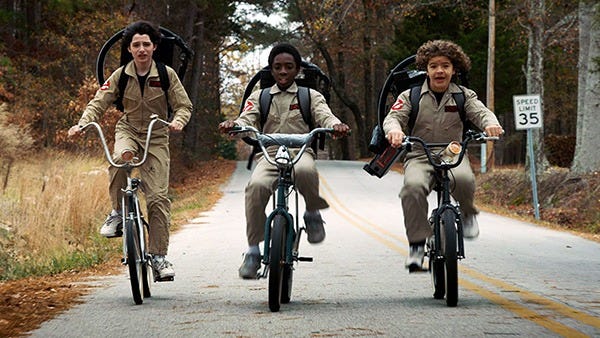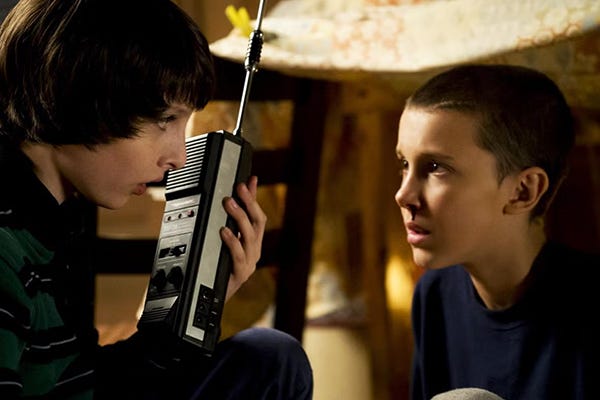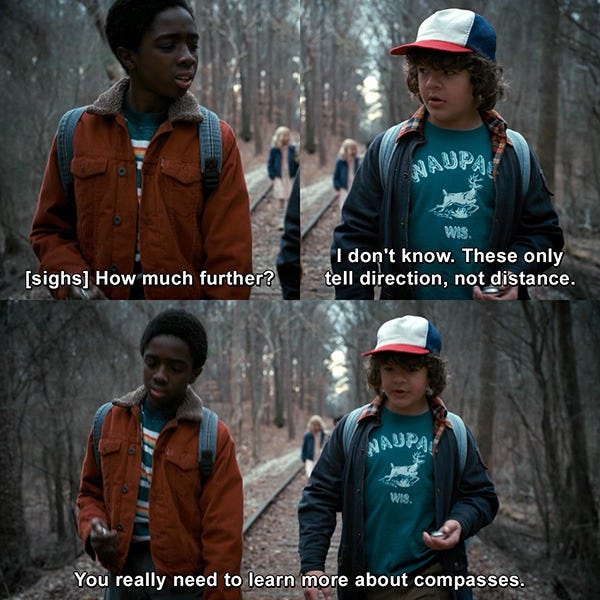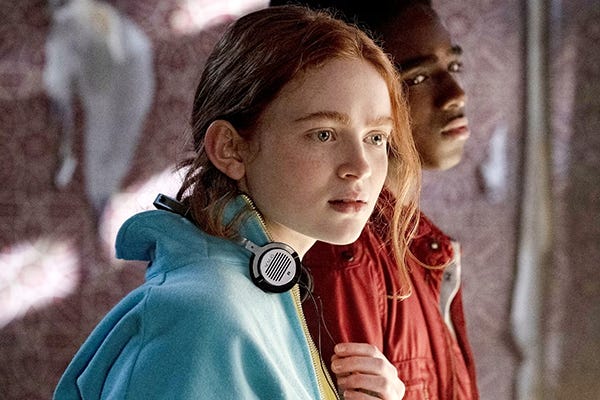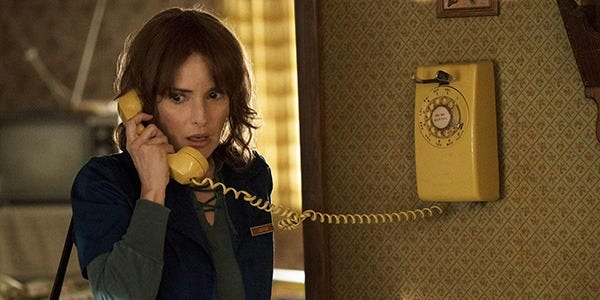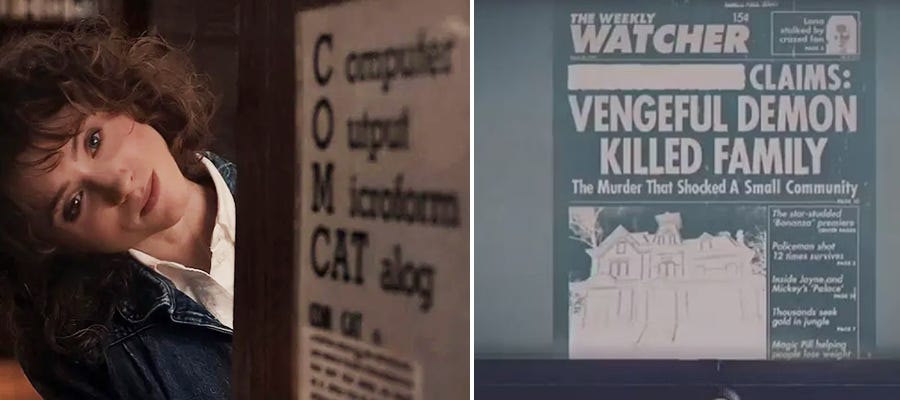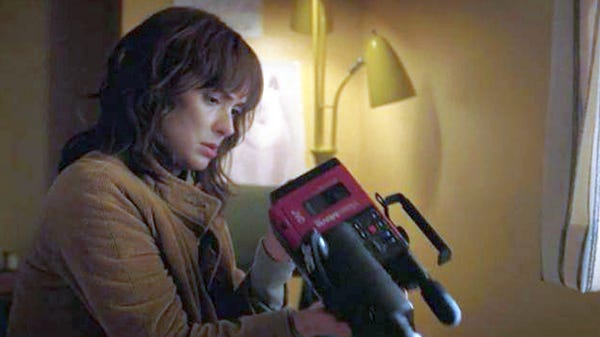How Retro Technology Shapes the World of Stranger Things
World building through old school tech
One of the things fans love about Stranger Things is its setting in place and time. The setting of the 1980s directly influences the plot, and it’s a lot of fun to participate in the nostalgia of the media, games, clothes, and of course, the technology of the era. From using bikes to ham radios to landline phones with miles of cords, the low-tech not only adds delight to the world-building of the show, but suspense too. Without cell phones, digital music, or GPS, the characters have to solve life-and-death problems with limited resources, at least by today’s standards. This takes time, and that keeps viewers on the edge of their seats as we watch Hopper piece through articles on microfiche or wait Max to rewind a cassette tape. We put together a list of the throwback technology used in the show.
Bikes
Bikes often symbolize both childhood freedom and the spirit of adventure. From the very first episode, the kids’ bikes are their lifeline. Since they aren’t old enough to drive, it’s their way to explore Hawkins, escape danger, and stick together when adults can’t be trusted. The show’s bike scenes echo classic 1980s films like E.T. and The Goonies, grounding the series in a nostalgic, small-town realism that viewers are already familiar with.
Walkie-Talkies
Walkie-talkies are a signature piece of gear in Stranger Things, capturing the resourceful, adventurous spirit of the Hawkins kids. They use them to stay in constant contact as friends but they come in handy when things get dark. Their use shows how imagination and teamwork can turn ordinary childhood gadgets into tools for survival.
Ham Radio
When Dustin builds his own radio, nicknamed “Cerebro,” it’s more than a science project. In a humorous scene, he drags his friends out to the hill it’s located on, but the implication that they need to go to great lengths to communicate with a stranger–Suzie–in Salt Lake City, adds some drama. Teens today could just connect over one of many social media platforms and a long distance phone call is as easy as pushing one button on a smartphone. For Dustin, a ham radio is the height of technology, and a life-saving window to the world outside of Hawkins.
Compass
The compass becomes a clever tool of plot development. When Dustin realizes their compasses are behaving strangely, it leads the kids to uncover the presence of a magnetic disturbance, and ultimately, the hidden gate to the Upside Down. The simple tool turns into a detective device, showing how their scientific thinking and teamwork help them uncover supernatural truths lurking beneath Hawkins’ ordinary surface. But would a modern day teen know how to read one?
Sony Walkman
Few other pieces of technology are as iconic as the Walkman in this show. But it’s more than just a retro accessory: the Walkman becomes a lifeline for Max, the ultimate “assertion of independence.” As Vecna comes for Max, the Walkman aids her in blocking out fear and his control by listening to her favorite song, “Running Up That Hill” by Kate Bush over and over–though she has to keep rewinding, adding to the suspense and race against time.
Corded landline wall phone
Landlines mounted on the wall with corded phones are decidedly nostalgic, a hallmark of the 1980s. In this show, they are lifelines for the residents of Hawkins, and even more so for Joyce when she realizes Will is trying to contact her from the Upside Down through the phone. Wired phones emphasize the slower, more deliberate pace of 1980s life, where every call carried suspense and connection was tangible. Every time a phone rings in the show, it is played for jump scares and dramatic effect.
Microfiche machine
A microfiche, used to scan newspaper articles from the past, is prominently used in the show. Hopper uses one to do some research, adding dramatic tension given the time it takes him to uncover information about the Hawkins Lab. Same for Nancy and Robin, who spend a lot of time going through archives. The Broadway play, Stranger Things: The First Shadow, begins with a montage on screen of microfiche sounds, revealing headlines from Hawkins through the years. It’s a piece of technology that is far more dramatic than a Google search.
Commodore Amiga 1000 computer
Suzie uses an Amiga 1000 computer, released in 1986, to hack into the Hawkins High School database to change Dustin’s grades. While fans were excited to see the old machine in the show, they were also quick to point out the anachronisms the show misses regarding the computer. Nevertheless, its existence, combined with the fact that Suzie has to sneak around her father to use it, adds suspense to the plot. In this world, a home computer is an incredible thing–not at all comparable to today’s world where folks are watching this very show on multiple individual computers and devices.
1984 JVC GR-C1 Camcorder
Bob Newby, a Radio Shack employee and bit of a technology geek, lends this camcorder to Will so they can document their trick-or-treating adventures on Halloween. If you think you’ve seen this device before on screen, you have: it’s the same camcorder that Doc gives to Marty McFly to record his time travel experiment in Back to the Future. Just like Marty ends up getting more than he bargained for on tape, Will is visited by the shadow creature while filming. The result is static on the tape, which helps Joyce realize that Will had another episode.
Want to do more with your fandom? Our Discord is where you’ll find everything you need to know about our fandom-forward ecosystem at Remarkist! Don’t forget to follow us on Instagram, tumblr, and Spotify for more storyworld content—and hit that subscribe button so you never miss a thing at rmrk*st Mag!





